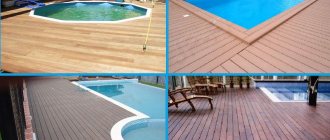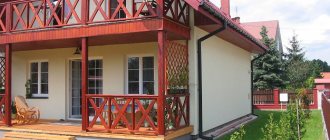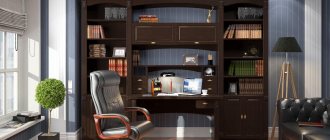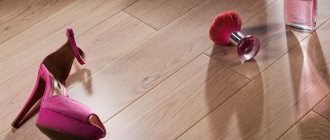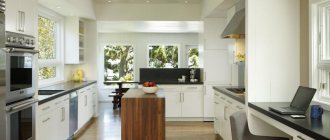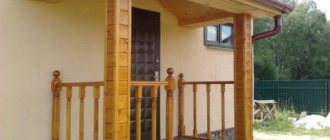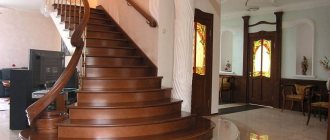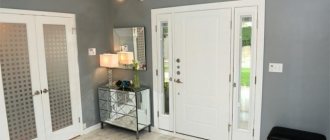Glazing options for verandas and terraces
There are a huge variety of glazing methods, so the owner of a country property has an excellent opportunity to choose the best option. However, it is necessary to take into account not only the strengths of each method, but also its disadvantages, which can complicate the operation process.
Full and partial
Partial is the installation of glass when arranging buildings that have blank walls. The advantages of this method are represented by low cost and availability for local replacement of elements that have become unusable. The disadvantages are a very limited view and poor aesthetics. The panoramic method involves glazing three walls, and sometimes the roof, which gives the best possible view. The disadvantages include the rather high cost of such design and the creation of an aquarium effect.
Partial is the installation of glass when arranging buildings that have blank walls
Frame and frameless
The frame method of arrangement is budget-friendly. Such structures are easy to transport and manufacture, and it is also possible to replace individual elements and install the frames yourself. However, it is impossible to create non-standard structures, so the building will look very impersonal.
The frameless method is an elite and very modern trend, allowing you to create a structure of a unique configuration with a panoramic effect, elegant and stylish, while maintaining natural light. The disadvantages of frameless construction are represented by insufficient thermal insulation qualities due to the lack of complete sealing of the seams, as well as high cost.
Glazing with sliding and swing structures
Hinged windows are manufactured with sashes, which are made in a standard turning version or are equipped with a tilt-and-turn mechanism. In various designs, the sash can open not only inward, but also outward. Depending on the components used in production, such blocks can vary quite significantly in weight.
Sliding-type blocks are most often made on the basis of aluminum frames, but sometimes they can be made of wood or modern plastics. In the casements of such structures, one thick glass is installed with the ability to mount a mosquito net. There are also ultra-modern and very beautiful frameless designs, in which there are no frames at all. The doors of such products consist exclusively of glass, which does not allow the use of mosquito nets.
Sliding-type blocks are most often made on the basis of aluminum frames
Winter and summer glazing
Cold or summer and warm or winter glazing has a number of significant differences that must be taken into account in the process of choosing an option and direct installation of the structure.
The first option involves installing frames based on lightweight and durable aluminum profiles with five-millimeter double-glazed windows. The advantages are represented by an affordable price, good protection from noise and dust, as well as the ability to install additional heaters. However, replacing glass in this case will be very labor-intensive, and among other things, operation is accompanied by large heat losses.
Sliding panoramic glazing
Sliding panoramic glazing for winter gardens
This method of arrangement is especially in demand in winter gardens, where, as a rule, automatic heating is used to thaw the snow mass, an automatic method of maintaining the microclimate and temperature indicators.
For a seasonal winter garden, glazing with an aluminum profile is being considered, which allows you to create a lightweight and beautiful, but not at all warm, sliding-type structure. The flower garden needs sufficient lighting. Disassembling such a system is quite simple and does not require much time or effort. The warm glazing method allows you to retain heat in the winter garden even in fairly severe frosts, but only if there is a good source of thermal energy.
Features of do-it-yourself glazing of a veranda in a wooden house
When glazing a country house with your own hands, preference is usually given to wooden glazed frames and ready-made PVC blocks
Before starting work, it is very important to make correct calculations of the number and size of structures, as well as the location of windows. For self-production of wooden frames, well-dried wood without cracks is selected
It is best to use glued material for this purpose, since solid timber or boards often dry out. Then a wooden box is made, which is inserted into the window opening. The box can be made of boards measuring 5x15 cm. To make the frame, a beam with a section of 5x5 cm is used. One or more glasses can be inserted into the finished profile, for which grooves are cut. At the final stage, you need to screw hinges and latches onto the doors, and also coat all structural elements with protective paints or varnish.
Features and Benefits
Glazing a veranda is that rare case when, among the many advantages, the disadvantages are lost. The room can be warm or cold. In the first case, it can be used in winter as a residential space. If the glazing is cold, then the temperature inside the veranda will be only a couple of degrees higher than the temperature outside, that is, the difference is insignificant. This veranda can only be used in summer. The advantages of glazing a room include:
- Protection from wind and rain (for both cold and warm options).
- Noise insulation.
- Possibility of arranging a separate room. In the case of cold glazing we are talking about a “summer residence”. With warm glazing, the room can be used all year round, that is, another full-fledged room is added to the living space on a “permanent basis”.
- Possibility of connecting to heating and using the room in winter (only for warm glazing). It is quite possible to arrange a bedroom, a small guest room, a winter garden, a storage room and a kitchen or dining room here. The choice of functional purpose depends entirely on the size of the veranda itself and its capabilities.
- Creating a stylish, unusual element of the interior and exterior of the house. Glazing can be different, and original solutions will emphasize the creativity of the design of the entire building as a whole.
If we mention the features of the glazing of the veranda, then it should fit well with the design of the house
This is a mandatory and most important condition
Next, you should pay attention to the area of the translucent sheet in order to provide it with proper support in the form of frames and at the same time not reduce the strength of the entire structure. The next stage is the choice of material for the frame, but we will talk about this in detail later.
Modern glazing systems offer great opportunities for owners:
- Partial roof covering with sheets of heavy-duty glass.
- Exact repetition of the shape of the veranda.
- A variety of door and window opening systems.
- Adjusting the width and height of open door and window openings.
- Possibility of installing mosquito nets.
Now let's talk about the types of glazing, their disadvantages and advantages.
Which fireplace is best for a terrace?
Of course, everything here depends on our wishes and preferences. If the mobility of the device is important to us, we need to pay attention to the type of steel. Cast iron fireplaces, although much heavier, are characterized by enormous strength, thanks to which they can be used by us in a variety of ways, using differentiated fuels.
For lovers of original design, it is recommended to pay attention to clay and ceramic fireplaces. It is also worth considering the possibility of using a fireplace in the form of a grill or oven. This will certainly diversify your holiday on the site and allow you to spend more pleasant evenings outdoors with friends and family.
Types of glazing of courtyard outbuildings
It has been proven that an unusual solution of many designers was the use of multi-dimensional glazing, which is a kind of indicator of the development of modern technologies. This is especially visible in the photo of the terrace glazing.
- What metals are used for glazing verandas and terraces? The main ones include:
- frame structures made of wood;
- decoration using metal-plastic throughout the entire height of the room;
- aluminum profiles;
- panels for sliding glazing of terraces;
- use of polycarbonate;
- technique without the use of frames.
The most popular are the use of frame structures and their complete absence.
There are a number of advantages that wood and aluminum frames have:
1. Price. It is accessible to almost all segments of the population, and this will greatly save not only money, but also time.
2. Interchangeability. Refers to individual elements, thanks to modern analogues as a result of severe wear and tear of older versions.
3. Independence. Gives you the opportunity to do the necessary work yourself.
The only drawback of these structures is the lack of repairability in unusual buildings, which include sliding glazing of verandas and terraces.
The method of frameless glazing of terraces and verandas has a number of excellent indicators, which include:
- use in any type of premises, even the most unconventional ones;
- creating a panoramic effect on the terrace;
- stylish appearance;
- complete preservation of natural lighting.
In addition to a large number of advantages, you should pay special attention to the disadvantages, of which there are not so few:
- reduced thermal insulation characteristics;
- it is not possible to install mosquito nets;
- the seams are loose;
- considerable cost.
Having studied all the pros and cons, we can conclude that such a design of terraces is more suitable for lovers of beauty and something unusual than for those who prioritize functionality.
Door options for glazing terraces and verandas
There are also several designs here.
The most popular direction is sliding glazing of verandas and terraces . Skids are used along which guide rollers move.
There is only one disadvantage of sliding doors - deformation of the fittings if they are of poor quality.
The advantages of sliding doors for glazing a veranda
- Easy replacement;
- Elegant design;
- Versatility. Can be used for any designs;
- Saving space;
- You can remove part of the wall if necessary.
The advantages of accordion doors are their uniqueness and small space for opening/closing. The disadvantages are the difficulty of replacement and the design itself.
Universal swing doors are suitable for any design, but require a lot of space to open.
We've sorted out the materials. Let's move on to the types of glazing of a veranda or terrace.
Design and decoration of terraces
The design of the veranda is selected to match the stylistic design of the house. The interior of this room should not stand out from the overall composition. Most often, verandas are used as a relaxation room. A wide sofa, armchairs, and a coffee table are placed here. The outside walls are covered with hops, grapes or ivy, and the windows are hung with light curtains. When the dimensions of the room allow, its interior is complemented with a couple of shelves with books and a cozy fireplace. If a loft is chosen as the main direction, then brick prevails in the decoration, and it is better to choose glazing with aluminum profiles. Similar designs are suitable for high-tech and modern style. Provence, modern, classic, chalet, and a number of ethnic styles are more impressed by wood. Plastic is universal and can be combined with any modern styles, but it is not suitable for luxury apartments, where every element of the interior should be associated with luxury.
Important points of glazing of gazebos, verandas, terraces
A veranda is different from a terrace. The first is the entry element. It can be located inside the walls, or outside, as an extension, where it serves as an additional room. The veranda usually has a roof and is installed on a foundation. It happens that a veranda is added later than the house - it looks like a structure installed on poles or reinforced concrete tiles.
Please note! Often the veranda is designed with glass, although sometimes it looks like a regular frame and railings. Then the owners of the house may want to organize the construction of full walls and glaze the veranda.. https://www.youtube.com/embed/hvuuvCXcJQU
856dbe1377bdf8f2acd02fac5f84e113.jpeThe terrace is a separate extension. It can be adjacent to or located near the house, with or without a roof. If there is no roof, you will need to build one before glazing - aluminum profiles will help here. Glazing of terraces and verandas has its differences, but the main points in choosing technology and materials for glazing roofs and terraces are as follows:
- Using an aluminum frame, both large and small buildings of any shape are glazed.
- They are building a room where plastic windows act as walls.
- Glazing without a frame looks most atmospheric; tempered glass 2 cm thick and strong sash profiles are used for it. Their dimensions reach 3 m, and they come in different shapes. Visually, this expands the space and provides maximum visibility.
Aluminum profiles are suitable for both types of verandas. Reliable fittings and door seals ensure safety during operation.
For terraces without heating, you can use a cold type of glazing:
- Glazing without frame (or frameless glazing of terraces and verandas).
- Panoramic systems transmit light best. The windows are large, spanning the entire height of the walls. If there is no winter heating, then it is better to take a structure without a frame. It looks like walls made of glass, since the fastening parts are invisible.
- Having chosen frameless technology, it is worth calculating the number of sashes. Some elements are sliding. This structure does not provide complete tightness between the veranda and the street.
- Metal/wood frame with regular windows.
- Polycarbonate sheathing is a cheap design, but can look quite nice. It is easy to assemble and easy to disassemble.
- Folding/sliding glass door for veranda, terrace, gazebo, which saves space.
- Double-glazed windows retain heat and do not block outside light. Metal-plastic structures perform this role most effectively.
The choice of the optimal technology and its price depend on whether heating is planned. The most expensive method is panoramic glazing of terraces and verandas, including double-glazed windows and wooden frames
If the issue of saving is urgent, you can pay attention to PVC or aluminum profiles
Features of glazing on the veranda and terrace
The veranda and terrace have some differences. The veranda is a part of the house that stands on the same level as the building itself. The veranda has a foundation, walls , window openings and a roof .
Veranda with glass roof
Cozy veranda with panoramic glazing
Advice! Since the veranda is part of the house, if there is heating in it, it makes sense to install warm glazing here, which will not only protect you from precipitation, insects and noise from the street, but also create an all-season recreation area.
If there is heating on the veranda, it makes sense to install warm glazing here
Warm glazing will not only protect you from precipitation, insects and noise from the street, but also create an all-season recreation area
A terrace is a separate building that can be adjacent to the house or stand apart. A terrace is considered an open area in the fresh air, which stands on a raised base and has only a roof on racks (sometimes the building has low railings).
Glazed terrace
A warm glazed terrace will allow you to have a pleasant time even in winter
Advice! For a terrace, warmth is not the most important condition, and therefore you can get by with cold, but bright and effective frameless glazing.
Terrace with bright and spectacular frameless glazing
A terrace with panoramic glazing will allow you to merge with nature, but at the same time be protected from its unpleasant surprises
Since quite often a terrace, like a veranda, is designed as an extension to a house, these concepts have long become practically synonymous.
Terrace and veranda have long become almost synonymous
How to glaze a veranda/terrace: recommendations
If you do not plan to spend a lot of money on furnishing and insulating the room, then the best option is aluminum windows on a parapet, or on a solid base made of the same aluminum. It will be cheap, quite nice and reliable. And rare freezing of the sashes in winter will not cause much trouble, since this is not a balcony where they need to be used constantly.
For budget warm glazing, the only option is standard plastic windows installed on a parapet or on the floor. Of course, they are not sliding, but they are convenient to use, plus they don’t freeze and look beautiful.
If you don’t want banality at all, then you can use colored aluminum and plastic. The decorative effect will immediately increase significantly. Aluminum is painted with powder paint according to the RAL catalogue, PVC is laminated (imitation of wood texture is most successful). Both coatings will remain until the end of their service life.
You can order colored plastic windows from almost any window company. With colored aluminum it is more difficult. They accurately manufacture good painted aluminum windows here: https://www.osteklenie-servis.ru/. This company also glazes verandas, so in theory they should take on the installation.
For luxury housing, the above methods are not suitable, since the windows will not be in harmony with the overall high cost of the interior. And for the premium segment it already makes sense to use frameless or sliding glazing (slider, accordion, PSK portals). The most practical, in our opinion, is sliding glazing like sliding doors and warm glazing using portals.
Frameless glazing is not suitable for every room and the design is not for everybody. But complete transparency makes it the best in cases where there is a beautiful view in front of the veranda or terrace.
Do not forget that all luxury window structures have a significant weight and create a high load. They need reliable buildings, preferably made of concrete. Well, production takes a lot of time, since components and profiles often have to be imported from Europe.
Hearth on the veranda: features
An open veranda, terrace or patio at the dacha is a familiar element. The house is more often used in summer than in winter, as a rule, it has a lightweight structure, and is often built entirely from wood. For the same reasons, it makes no sense to equip a full-fledged kitchen here with a lot of appliances and equipment. Moreover, you can and should use every opportunity to transfer the cooking process outside. A veranda or terrace is best suited for these purposes.
The fact is that a fireplace located outdoors, of course, can perform its functions, but it is not durable. Brick, no matter how durable, is destroyed quite noticeably under the influence of sun, wind and rain. On the veranda or terrace, the effect of weather factors will be much weaker.
Installing a fireplace on a partially or completely closed area, if, for example, we are talking about a glazed veranda, has one feature. For normal operation of the fireplace, it is necessary not only to remove the burnt gas, but also to supply fresh air. A device with an open firebox takes air from the room, and if this is not a problem for an open area, then for a closed veranda you will have to use one of the solution methods.
- High chimney - 1.5 m above the roof ridge. The higher the chimney pipe, the better draft it creates. This means that with normal ventilation of the room, the stove will operate without failures.
- Low chimney - at roof level, and forced air supply. In this case, a pipe is placed in the floor under the fireplace insert, providing air supply from the street. This option is more difficult to do with your own hands.
Another condition that is not required to be met when constructing an outdoor fireplace, but will be required for a structure in a house, is finishing the safety zone with non-combustible materials: laying wooden flooring boards under the wall of the structure is unacceptable, the passage of the chimney pipe through the ceilings and walls must be reliably insulated.
A variety of types of fireplaces are built at the dacha:
- just a hearth, suggesting only an aesthetic function,
- a grill where meat is fried directly on coal - it is advisable to sharpen this option outside:
- a barbecue oven is more suitable for construction in a gazebo or on a terrace;
- a stove with a hob and fireplace insert is, of course, the most labor-intensive structure, as it will require the installation of two fireboxes - for the hearth and for the hob. However, this model performs all the functions of a summer kitchen.
The photo shows an option with a hob and worktop.
Features and Benefits
Country houses are built to provide an opportunity to take a break from the everyday hustle and bustle and work routine. Therefore, people, sparing no expense, decorate their homes with all sorts of attributes of coziness and comfort. Nowadays it is difficult to imagine a country house without a terrace or veranda, thanks to which a person can relax and enjoy nature. They allow you to become part of the natural atmosphere without leaving civilization. To fully understand the features of a terrace and veranda, you need to know their definitions.
A terrace is an extension to a house, which in most cases serves as a recreation area. Such an attached area is a room that is not closed from the air, usually equipped with a roof, railings or a special frame. Often the terrace is placed on the ground, since it is quite easy to build an extension on the ground. There are also cases of its location above the lower floor, if the building design allows it. Although the upper floors are usually equipped with a veranda.
It is designed in an existing building on the side of the wall facing the street. The veranda can also be an extension to the house. Its peculiarity is that it is protected from the street space by a glass covering. The advantage is that glass will not interfere with merging with nature and enjoying its views.
Veranda and terrace areas are usually extensions and are very similar in definition, so they are often confused. This is due to the fact that despite the strictness of the terms, only the owner of the house decides how to organize his veranda or terrace. That is, the terrace can be glazed, and the veranda can be heated. Extensive experience in glazing extensions has made it possible to assign a wide range of functions to this coating. Depending on what you want to get from a glazed fence, its type is selected.
The main advantage of glazing the site is that it creates an invisible wall that restrains unwanted influences on the room. This means that unpredictable climate and swarms of insects will not be able to disturb the peace. But at the same time, the positive aspects of recreation areas remain unaffected. After all, the visual satisfaction in a glass box is the same as without it. You can fall in love with the feeling of being able to watch a downpour and stay dry.
Without extra effort, it will be possible to organize a space for family recreation, social gatherings, and bring to life a corner of civilization that will coexist with nature. And the only thing that can prevent this is drips on the glass, which, of course, need to be washed often.
Which terrace fireplace should you choose?
In order to choose the right mobile fireplace for your site, you need to pay attention to its parameters.
Material of manufacture
This is the first and most important parameter that must be taken into account when choosing a terrace fireplace. This is reflected in the durability and reliability of the device.
The steel deck fireplace is one of the most popular products in the market. The steel sheet from which the hearth is made is usually coated with a special protective paint, which makes the body resistant to very high temperatures. It should also be mentioned that steel devices are available in stores in a wide range.
Today you can choose a fireplace for your site in the shape of a sphere, square or triangle. There are also designer models on the market that even resemble a lighthouse or a cone, which looks like a chimney with a roof. Of course, we can buy fireplaces in different sizes, taking into account our needs and wishes.
A cast iron fireplace for a terrace is characterized, first of all, by its heavy weight, which makes it somewhat difficult to carry. However, we note that the use of cast iron significantly increases the strength of the fireplace - this applies not only to long-term operation at high temperatures, but also to possible mechanical damage.
Moreover, a cast iron fireplace stays warm longer than a steel model. That is, the high temperature nearby remains even after the fuel has burned. It is recommended to choose devices equipped with a special plate that facilitates ash removal. On the market we can also find models specially adapted for gardening.
Ceramic Terrace Fireplace - Its main advantage is its extremely attractive appearance, inspired by traditional Mexican clay ovens. They are characterized by very complex shapes that will enrich the decor of our terrace or garden. It should also be emphasized that this type of fireplace retains heat for a long time, which makes it ideal for grilling and baking sausages.
The disadvantage of ceramic fireplaces is that they take a long time to heat up. If this is unacceptable, you should pay attention to clay ovens. They heat up much faster and maintain a constant temperature for a long time. It should also be noted that clay fireplaces are safer - there is no risk of getting burned by touching a hot sheet. Their main feature is the decor of the site, so they are often decorated with numerous patterns.
How to choose the ideal plot for a house from thousands of offers?
Structural (textured) paint. Which one is better to choose for painting the walls of a house?
How to choose a log house and determine the quality of logs for a wooden house?
We arrange the living room of the house according to Feng Shui
Exterior decoration of the balcony in the house. How to choose a balcony covering?
Wireless Internet in the house. How to connect a computer?
Searching for a cheap and quality home to buy. Why is everything so difficult?
Construction of a log house. Traditional and modern technologies
How to properly control the construction (construction) of a country house?
Apartments in cottage villages near Moscow. Low-rise residential complexes in the Moscow region
Fuel
Having decided to buy a fireplace for the terrace, we must definitely study what types of fuel can be used in it. On this basis they are divided into:
- wood-burning terrace fireplace;
- fireplace for the terrace using briquette fuel;
- terrace fireplace for coal (these are exclusively models made of cast iron, which are highly durable);
- gas fireplaces for the terrace (gas is supplied from a bottle attached to a set, which is usually placed in a specially prepared housing; it is recommended to choose models based on the use of electronic detonators, and also including flame control. Many of the fireplaces are also equipped with an automatic burner switch).
Application area
A traditional fireplace on a terrace is used primarily for heating. However, on the market you can also find models that operate in grill mode and are equipped with appropriately adapted ovens, with which we can even cook bread or pizza.
Warm glazing of the veranda
If you plan to use the veranda as a winter garden or simply as an additional heated room, then you must choose exclusively warm glazing. It is made of a multi-chamber PVC or solid wood profile with double-glazed windows and seals.
- First option.
A parapet is erected from concrete, brick or other durable material. Classic windows with tilt-and-turn fittings are installed on top of it. A swing door is installed separately.
This glazing option is used on balconies and loggias. It provides a high level of heat and noise insulation, looks good and has an impressive service life (up to 40 years).
Cost from 8000 rub. for 1 sq. meter excluding the costs of erecting the parapet.
- Second option.
Instead of a parapet, blind windows are installed on the floor. Sections with blind and tilt-and-turn sashes are already installed on top in any ratio. The design is uniform, which guarantees high strength.
Price from 10,000 rub. per square meter The level of heat and noise insulation is also very high, as is the service life.
Pros: more light enters the room, more beautiful view from the street. Cons: lower double-glazed windows are easier to break due to negligence
- Third option.
Floor-to-ceiling structures with sliding doors are used (for example, PSK portal from REHAU). The profile is reinforced with increased strength and can withstand the load from high and heavy double-glazed windows.
This veranda glazing looks great and is very convenient to use. In terms of heat and sound insulation, it is inferior to the previous two options. But just a little, so special fittings are used that allow sliding doors to be tightly closed.
Price from 28,000 rub. for 1 sq. meter.
Pros: warm sliding. Cons: difficult installation, expensive, production usually takes 2 weeks or more.
The price indicated is minimal for PVC structures. Wooden ones, depending on the wood used, cost from 2.5 to 10 times more expensive. There are a number of combined glazing methods, where several of the above options are used. But in general, these three methods are the main ones.
Design
Depending on the main purpose pursued, a fireplace can perform several functions. Based on this, the following types of fireplaces can be erected on the terrace:
Harmonious interior of the surrounding area
- Closed grill - used for cooking and receiving aesthetic pleasure from watching the process of burning logs.
- A barbecue stove is an ideal option for installation on a veranda and is less dangerous than the first type of fireplace.
- A stove with a firebox and a surface for cooking - has a certain similarity with old stoves, which were used both for heating the room and for cooking.
- An ordinary fireplace or its imitation performs an exclusively aesthetic function.
As for the cladding methods, everything also depends on the type of fireplace built. The main thing in this process is to adhere to a single idea, and, if possible, to make sure that the fireplace fits into the design of the surrounding space as much as possible, complementing it and making the atmosphere around even more cozy and comfortable.
Cold glazing of the veranda
If heat on the veranda is not required from mid-autumn to mid-fall, then cold glazing methods can be used. There are many more of them and the differences between them are much more significant.
First option.
Aluminum sliding windows are installed on the parapet, and an aluminum door with a horizontal impost is installed separately. The result is the most convenient sliding glazing with a swing door.
Price from 6,000 rub. for 1 sq. meter.
Cons: the fittings freeze in severe frosts, preventing the doors from opening. Pros: cheap, beautiful when properly finished, long service life (up to 20 years), paintable.
Wooden frames with single glass can also be used instead of sliding doors. They have a shorter service life and are more expensive, but when it is necessary to style the glazing for the interior, they often help out.
9f0b5e627f9f2bc2f0997f5d86cca0bd.jpePrice from 8000 rub. for 1 sq. meter. Cons: the most short-lived windows (last about 7-8 years), no ventilation mode, hinged sashes, no mosquito nets. Pros: decorative, cheap.
Second option.
Sliding doors are installed from floor to ceiling, sliding right/left, or only in one direction. Material aluminum or PVC. Unlike portal doors, the data is on different guides and does not close tightly enough. Therefore, the opening is wider, and the heat and noise insulation is an order of magnitude lower.
There are such designs as with double-glazed windows and with single glass (tempered or triplex). Both are classified as cold, but the first ones still protect better from the cold and freeze less often.
Sliding doors can be used in conjunction with blind sections the full height of the opening.
Price from 12,000 rub. for 1 linear meter. Pros: beautiful, very comfortable, practical. Cons: you can only open part of the opening; most sliding systems require a threshold.
Third option.
Sliding systems are used that open in the form of an accordion. This type of sliding allows you to both free up almost the entire span and remove only the required number of sections. The sections fold up quickly and easily.
It is possible to install systems with a threshold and a guide embedded in the floor, which does not interfere.
Price from 20,000 rub. for 1 linear meter. Pros: originality, freeing the opening from glazing if necessary, high decorative qualities, possibility of installation without a threshold. Disadvantages: expensive, some people find accordions inconvenient.
Fourth option.
Glass sections are used with barely noticeable sealing elements on the sides of the glass and fastening at the top/bottom. Sections, one at a time, unfold perpendicular to the opening and move to one side. Thanks to this, you can open any part of the veranda.
Currently, this type of frameless glazing is the most trendy and prestigious. Including due to the ability to close the veranda or terrace, at the same time, without limiting the view and penetration of sunlight.
Can be installed on a parapet or blind lower sections.
Price from 25,000 rub. for 1 linear meter. Cons: one of the most expensive glazings, not very convenient for daily use. Pros: absolute transparency, durability, prestige.
Construction materials
The glazing frame can be made of plastic, wood and aluminum. The materials are arranged by popularity, starting with the most popular. Of course, at first plastic began to be used everywhere in the glazing of city apartments. Gradually, it migrated to private homes, but wood and aluminum here continue to stubbornly hold their own. This is especially good for wood, which is involuntarily associated with the warm atmosphere of a country house and fits perfectly with the design in the chalet, country, and Provence styles that are so often used in the outback.
Aluminum
The main advantage of aluminum is its light weight. The material allows you to make the structure much lighter, but without compromising its strength. In terms of cost, aluminum also outperforms its main competitors. For comparison: the price of plastic glazing is twice as high as installing a similar aluminum structure. Unfortunately, the material did not become widely used due to its main drawback: the design retains heat very poorly.
A veranda with an aluminum profile can only be used in summer; in winter, it is most logical to install an “outdoor freezer” here. Although now manufacturers offer a rather expensive solution to this problem - thermal inserts and special liners that retain heat and create additional sound insulation. The aluminum profile is fireproof, so the risk of the structure igniting is reduced to zero, which becomes another advantage of the material when compared with wood.
Tree
Previously, only wood was used for glazing houses (not only verandas). With the advent of alternative options, this material began to be slowly forgotten, but its advantages did not fade. Wood has high noise and heat insulation. Although, of course, the glass itself receives the main “blow” in terms of heat conservation, a lot also depends on the frames. Unlike plastic or aluminum, wood does not need additional thermal liners, since the material itself prevents cold from entering the room and warm air from escaping outside. Wood has micropores, which allows it to “breathe”. Manufacturers of plastic double-glazed windows state in their characteristics that the maximum minus for the material is 30 degrees below zero. At this temperature, PVC loses strength and becomes brittle.
For wood, there is also a frost resistance limit, but this figure is so sky-high (minus 120 degrees) that even in the conditions of the Far North it is impossible to verify it. From this we can conclude: wood is the warmest material. The wood is environmentally friendly, but it will catch fire when in contact with an open flame. The material is pre-treated with special impregnations, which increase its fire resistance and moisture resistance. Contact with liquid is dangerous for wood. Material that is not properly processed can become deformed, rendering the double-glazed window completely unusable. And the main advantage of wood lies in its beauty, which neither aluminum nor PVC has. Warm, homely, “cozy” material will ideally highlight the design of an Alpine chalet, simple country, French Provence and rustic Russian style.
1405c8545f06e92eba07e3854176bcc0.jpe
Plastic
Contrary to misconceptions, high-quality plastic does not emit harmful substances during operation. PVC retains heat perfectly, thanks to special rubberized inserts around the perimeter of the window and door sashes, the veranda remains airtight. Plastic windows provide good sound insulation. They are ideal for warm glazing, but are heavy, so they are not recommended for use in dilapidated dachas or old country houses. PVC cannot be called fire-resistant, but upon contact with an open flame, they do not catch fire, but begin to melt, releasing caustic substances.
Perhaps the main disadvantage of plastic glazing is its high cost. If you need to install one or two windows, then the purchase and installation will not hit the budget much, but for a panoramic double-glazed window you will have to spend a lot of money. Wood and aluminum leave PVC far behind in this regard, luring buyers with tempting prices.
Advantages
Almost every private house has an open or closed veranda. Considering that the dacha is used only in the warm season and is not the main place of residence, such a structure does not always allow it to be equipped with a full kitchen. In this case, the owners install a fireplace on the terrace.
Of course, you can quite easily build a large barbecue or equip an open-air barbecue area, but sooner or later the structure will still fall into disrepair, no matter how durable and high-quality materials are used during construction. In a closed veranda, negative environmental conditions, such as wind, rain and scorching sun, do not affect the fireplace, so it will last many times longer.
Recreation area for the whole family


